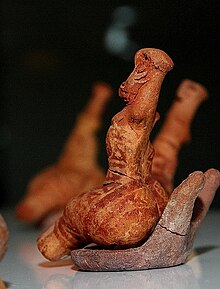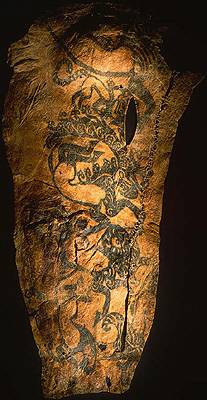Indonesia
Several Indonesian tribes have a tattoo culture. One notable example is the Dayak people of Kalimantan in Borneo (Bornean traditional tattooing).[edit] Europe
Pre-Christian Germanic, Celtic and other central and northern European tribes were often heavily tattooed, according to surviving accounts. The Picts were famously tattooed (or scarified) with elaborate dark blue woad (or possibly copper for the blue tone) designs. Julius Caesar described these tattoos in Book V of his Gallic Wars (54 BCE).Ahmad ibn Fadlan also wrote of his encounter with the Scandinavian Rus' tribe in the early 10th century, describing them as tattooed from "fingernails to neck" with dark blue "tree patterns" and other "figures."[3] During the gradual process of Christianization in Europe, tattoos were often considered remaining elements of paganism and generally legally prohibited.
According to Robert Graves in his book The Greek Myths tattooing was common amongst certain religious groups in the ancient Mediterranean world, which may have contributed to the prohibition of tattooing in Leviticus. However, during the classic Greek period, tattooing was only common among slaves.
Japan
Main article: Irezumi
Tattooing for spiritual and decorative purposes in Japan is thought to extend back to at least the Jōmon or Paleolithic period (approximately 10,000 BCE) and was widespread during various periods for both the Japanese and the native Ainu. Chinese visitors observed and remarked on the tattoos in Japan (300 BCE).Between 1603 - 1868 Japanese tattooing was only practiced by the "ukiyo-e" (The floating world culture). generally firemen, manual workers and prostitutes wore tattoos which communicated their status. Between 1720 - 1870 Criminals were tattooed as a visible mark of punishment, this actually replaced having ears and noses removed. A criminal would often receive a single ring on their arm for each crime committed which easily conveyed their criminality. This practice was eventually abolished by the "Meji" government who banned the art of tattooing altogether, viewing it as barbaric and unrespectable, this subsequently forced a sub culture of criminals and outcasts, many of whom were the old Samurai warriors ("Ronin" - Master less). These people had no place in "decent society" and were frowned upon, they were kept separate and simply could not integrate into mainstream society because of their obvious visible tattoos, this forced them into criminal activities which ultimately formed the roots for the modern Japanese mafia - "Yakuza" for which tattoos in Japan have almost become synonymous.
A tattoo is body art made by inserting indelible ink into the dermis layer of the skin to change the pigment. Tattoos on humans are a type of decorative body modification, while tattoos on animals are most commonly used for identification purposes. The first written reference to the word, "tattoo" (or Samoan "Tatau") appears in the journal of Joseph Banks, the naturalist aboard Captain Cook's ship the HMS Endeavour in 1769: "I shall now mention the way they mark themselves indelibly, each of them is so marked by their humor or disposition".
Tattooing has been practiced for centuries worldwide. The Ainu, the indigenous people of Japan, traditionally had facial tattoos. Today one can find Berbers of Tamazgha (North Africa), Māori of New Zealand, Hausa people of Northern Nigeria, Arabic people in East-Turkey and Atayal of Taiwan with facial tattoos. Tattooing was widespread among Polynesian peoples and among certain tribal groups in the Taiwan, Philippines, Borneo, Mentawai Islands, Africa, North America, South America, Mesoamerica, Europe, Japan, Cambodia, New Zealand and Micronesia. Despite some taboos surrounding tattooing, the art continues to be popular in many parts of the world.





